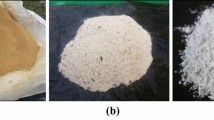Abstract
Rice hush ash (RHA) is a pozzolanic material and can be used in the lime treatment for soil stabilization without strict requirements of burning conditions. In this study, 3 samples of RHA collected from burning rice husk and 1 sample from burning rice husk firewood were considered. Their reactivity was identified in experiments with saturated lime solution. The results showed that they are classified as none to variable pozzolanicity. To evaluate their effect on the lime treatment on clayed soil, two sets of experiments were performed. The first set used 3 samples including the one from rice husk firewood and mixed with lime in the ratio of 1:1. The second set used the other sample combined with coal slag and lime. The results show that replacing partly the lime by RHA can give the same or even higher shear strength than that of using only lime, despite the results of low activity. Therefore, using RHA from simple burning conditions for soil stabilization is an effective and economical option.
Access this chapter
Tax calculation will be finalised at checkout
Purchases are for personal use only
Preview
Unable to display preview. Download preview PDF.
Similar content being viewed by others
References
Agarwal, S. K. (2006). Pozzolanic activity of various siliceous materials. Cement and Concrete Research, 36, 1735-1739.
Ashango, A. A. and Patra, N. R. (2016). Behavior of Expansive Soil Treated with Steel Slag, Rice Husk Ash, and Lime. Journal of Materials in Civil Engineering, 28(7), 06016008. doi:https://doi.org/10.1061/(asce)mt.1943-5533.0001547
Basha, E. A., Hashim, R., Mahmud, H. B., and Muntohar, A. S. (2005). Stabilization of residual soil with rice husk ash and cement. Construction and Building Materials, 19, 448-453.
Choobbasti, A. J., H. Ghodrat, M.J. Vahdatirad, S. Firouzian, A. Barari, M. Torabi, & Bagherian, A. (2010). Influence of using rice husk ash in soil stabilization method with lime. Frontier of Earth Science. China, 4(4), 471-480
Cook, D. J. (1986). Rice husk ash. In R. N. Swamy (Ed.), Cement Replacement Materials (Vol. 3). London: Surrey University Press.
Haji Ali, F., Adnan, A. and Choy, C. k. (1992). Geotechnical properties of a chemically stabilized soil from Malaysia with rice husk ash as an additive. Geotechnical and Geological Engineering, 10, 117-134.
Karatai, T. R., Kaluli, J. W., Kabubo, C. and Thiong’o, G. (2017). Soil Stabilization Using Rice Husk Ash and Natural Lime as an Alternative to Cutting and Filling in Road Construction. Journal of Construction Engineering and Management, 143(5), 04016127. doi:https://doi.org/10.1061/(asce)co.1943-7862.0001235
Liu, Y., Chang, C.-W., Namdar, A., She, Y., Lin, C.-H., Yuan, X. and Yang, Q. (2019). Stabilization of expansive soil using cementing material from rice husk ash and calcium carbide residue. Construction and Building Materials, 221, 1-11. doi:https://doi.org/10.1016/j.conbuildmat.2019.05.157.
Luxán, M. P., Madruga, F., & Saavedra, J. (1989). Rapid evaluation of pozzolanic activity of natural products by conductivity measurement. Cement and Concrete Research, 19(63-68).
Malhotra, V. M., & Mehta, P. K. (Eds.). (1996). Pozzolanic and Cementitious Materials (Vol. 1). Ontario, Canada: Gordon and Breach Publishers.
Muntohar, A. S. (2002). Utilization of Uncontrolled Burnt Rice Husk Ash in Soil Improvement. Dimensi Teknik Sipil, 4(2), 100-105.
Muntohar, A. S. (2006). Swelling characteristics and improvment of expansive soil with rice husk ash. In Amer Ali Al-Rawas & M. F. A. Goosen (Eds.), Expansive soil: Recent advances in characterization and treatment (pp. 435-452): Taylor & Francis/Balkema.
Seco, A., F. Ramirez, Miqueleiz, L. and Garcia, B. (2011). Stabilization of expansive soils for use in construction. Applied Clay Science, 51, 348-352.
UNIDO. (1984). Rice Husk Ash Cements: their development and application. Vienna.
Walker, R. and Pavía, S. (2011). Physical properties and reactivity of pozzolans, and their influence on the properties of lime-pozzolan pastes. Materials and Structures, 44, 1139-1150.
Acknowledgment
The authors sincerely thank Pham Huu Tuan, Nguyen Quang Huy and the student group who helped to perform the tests. And we also thank the Geotechnical Lab of Thuyloi University for the support during the test period.
Author information
Authors and Affiliations
Corresponding author
Editor information
Editors and Affiliations
Rights and permissions
Copyright information
© 2020 Springer Nature Singapore Pte Ltd.
About this paper
Cite this paper
Pham, V.P., Tran, V.T. (2020). Rice Husk Ash Burnt in Simple Conditions for Soil Stabilization. In: Duc Long, P., Dung, N. (eds) Geotechnics for Sustainable Infrastructure Development. Lecture Notes in Civil Engineering, vol 62. Springer, Singapore. https://doi.org/10.1007/978-981-15-2184-3_93
Download citation
DOI: https://doi.org/10.1007/978-981-15-2184-3_93
Published:
Publisher Name: Springer, Singapore
Print ISBN: 978-981-15-2183-6
Online ISBN: 978-981-15-2184-3
eBook Packages: EngineeringEngineering (R0)




